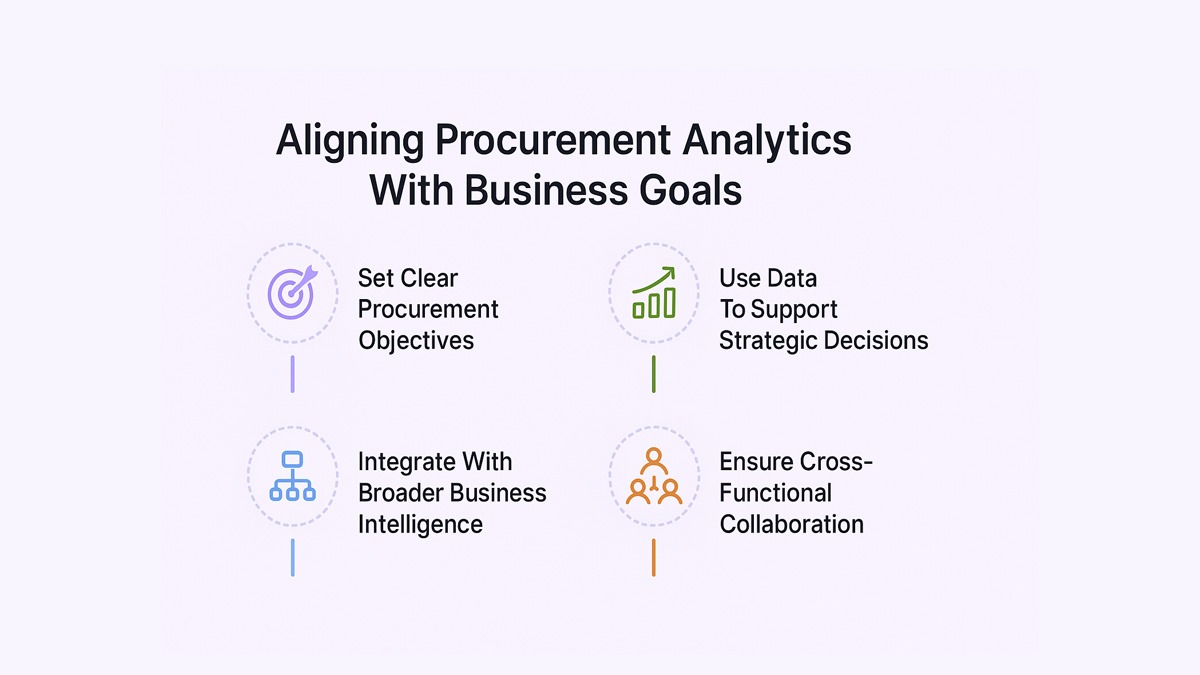

Procurement Data Analysis: Techniques and Methodologies That Unlock Hidden Value

Procurement Data Analysis: Techniques and Methodologies That Unlock Hidden Value
Explore how procurement data analysis drives savings, vendor performance, and smarter decisions across the procurement lifecycle.


Every purchase tells a story - of costs, choices, and outcomes. But when those stories are scattered across spreadsheets and systems, critical insights get lost in the noise. That’s where procurement data analysis steps in. It turns raw procurement data into sharp, strategic insights that fuel better decisions, cost savings, and supplier performance. Strong procurement strategies rely on accurate insights to align spend with business priorities.
What this blog covers:
- What is procurement data analysis?
- Why is procurement data analysis important
- Key areas of procurement data analytics
- Essential KPIs for procurement success
- Aligning procurement analytics with business goals
- How Spendflo helps with procurement data analysis
- Frequently asked questions on procurement data analysis
What is Procurement Data Analysis?
Procurement data analysis is the process of collecting, examining, and interpreting procurement-related data to improve purchasing decisions, optimize costs, and enhance supplier performance. It involves analyzing data from spend, contracts, supplier metrics, and market trends to drive smarter, data-backed strategies across the procurement lifecycle.
Why is Procurement Data Analysis Important
Procurement data analysis isn’t just about crunching numbers - it’s about creating clarity. Here’s why it plays a crucial role in modern procurement operations:
Improves Efficiency Across the Procurement Cycle
By analyzing cycle times and process delays, teams can identify inefficiencies in approvals, supplier onboarding, or PO creation. This leads to smoother workflows, reduced bottlenecks, and faster time-to-value in procurement.
Enables Smarter Supplier Decisions
Good supplier relationships start with great data. Analyzing past performance, delivery timelines, quality scores, and cost trends helps teams choose vendors based on facts, not guesswork - improving reliability and outcomes.
Drives Strategic Sourcing and Negotiations
Understanding your spend patterns and supplier leverage points is key to negotiating better contracts. Data-backed sourcing strategies lead to bigger discounts, reduced risks, and more favorable terms. Detailed spend analysis strengthens contract negotiations by highlighting leverage points.
Supports Risk Management and Compliance
Procurement analytics can flag compliance gaps, monitor contract expirations, and detect anomalies in spend - helping businesses avoid penalties and stay aligned with regulatory and internal controls.
Key Areas Of Procurement Data Analytics
Procurement analytics spans multiple areas of the procurement lifecycle. Descriptive analytics helps summarize past performance to guide improvements in future procurement cycles. Each focus area brings different insights - together, they drive a 360-degree view of performance.

Spend Analysis
This is the heart of procurement analytics. It involves categorizing and analyzing historical spend data to uncover saving opportunities, supplier consolidation prospects, and budget leaks. It helps answer: Who are we buying from? How much? At what frequency?
Supplier Performance Analysis
Tracking vendor metrics like delivery time, product quality, contract adherence, and responsiveness helps procurement teams maintain high performance standards. Supplier databases can centralize this performance data for easier tracking and analysis. Over time, this leads to stronger supplier partnerships and fewer disruptions.
Cost Savings and Forecasting
Data analytics allows teams to track achieved savings against targets and forecast future savings opportunities. Predictive analytics can even suggest areas where costs might rise, helping teams stay ahead of inflation or market volatility. Prescriptive analytics further enhances decision-making by recommending optimal sourcing actions.
Contract and Compliance Monitoring
By integrating contract data with procurement workflows, teams can flag expirations, monitor renewal deadlines, and ensure terms are being met. This minimizes missed obligations and improves audit readiness.
Essential KPIs For Procurement Success
Procurement KPIs aren’t just numbers on a dashboard - they’re indicators of health, efficiency, and strategic impact. These metrics show where procurement adds value, where it’s underperforming, and where it can do better. Here are some of the most critical KPIs every procurement team should track:
Cost Savings
This is often the North Star metric for procurement. It tracks how much money has been saved through sourcing strategies, vendor negotiations, contract optimization, or demand management. It includes both hard savings (like price reductions) and soft savings (like process improvements that reduce overhead).
Cycle Time Reduction
Cycle time measures how long it takes to complete key procurement activities, such as the time from requisition to PO or from PO to delivery. A shorter cycle time means greater agility, improved stakeholder satisfaction, and better alignment with business needs.
Supplier Lead Times
This KPI measures the average time suppliers take to fulfill an order from the moment it’s placed. Monitoring inventory levels alongside lead times helps avoid overstocking or shortages. It helps procurement teams assess reliability and plan purchasing cycles accordingly. Shorter and more predictable lead times can prevent stockouts and keep operations running smoothly.
Compliance Rate
This measures how often procurement activities follow established policies and procedures - such as using preferred vendors, following contract terms, or adhering to approval workflows. High compliance rates reduce risk, ensure audit readiness, and improve operational consistency.
Purchase Price Variance (PPV)
PPV compares the actual purchase price of goods/services to the expected or standard cost. Variances can point to issues in pricing negotiations or supplier inconsistencies - and can also highlight potential savings opportunities for future orders.
Supplier Defect Rate
This metric tracks the percentage of goods received that are defective or not up to specification. High defect rates signal supplier quality issues and can impact production, customer satisfaction, and procurement credibility.
On-Time Delivery Rate
This KPI tracks how often suppliers meet their promised delivery dates. It’s a direct indicator of supplier reliability and is closely linked to operational continuity, especially in just-in-time or lean environments.
Aligning Procurement Analytics With Business Goals
Procurement analytics isn’t just a reporting tool - it’s a strategic enabler. But for it to create real business value, it must align closely with organizational goals. Here’s how teams can make that happen:

Set Clear Procurement Objectives
Start by identifying what the business wants from procurement - whether it’s cost savings, risk reduction, sustainability, or speed. Analytics should be tied to these specific outcomes, not generic data collection.
Use Data To Support Strategic Decisions
Procurement teams should go beyond reporting and use analytics to influence sourcing strategies, budgeting, vendor partnerships, and innovation. Insights from data should inform what to buy, when, from whom - and at what terms.
Integrate With Broader Business Intelligence
Analytics shouldn’t live in a silo. Connecting procurement data with finance, operations, and supply chain insights allows for better forecasting, scenario planning, and cross-functional collaboration.
Ensure Cross-Functional Collaboration
To turn insights into action, procurement must work closely with stakeholders across departments. From finance to legal to IT, aligning on goals and sharing analytics dashboards keeps everyone rowing in the same direction.
How Spendflo Helps With Procurement Data Analysis
Procurement teams often juggle fragmented tools, manual spreadsheets, and limited visibility. That’s where Spendflo steps in. It brings all your procurement data - from spend patterns to supplier performance and contract insights - into one centralized, intelligent platform.
With automated tracking, real-time dashboards, and benchmarking insights, Spendflo empowers finance and procurement leaders to make faster, data-backed decisions. Whether it’s optimizing SaaS contracts, identifying duplicate tools, or predicting savings opportunities, Spendflo turns procurement data into actionable strategies that improve control and maximize ROI.
Frequently Asked Questions on Procurement Data Analysis
What are the most useful tools for procurement data analysis?
Popular tools include spend management platforms, ERP systems, and procurement analytics software like Spendflo. These tools centralize data and provide real-time insights to improve decision-making.
How often should procurement data be reviewed?
Ideally, procurement data should be reviewed monthly or quarterly. Frequent reviews help identify trends early, track performance, and stay on top of savings opportunities and risks.
What types of data are critical in procurement analytics?
Key data includes spend history, supplier performance metrics, contract terms, lead times, invoice accuracy, and compliance records. The more complete and accurate the data, the more valuable the analysis.
How can small businesses benefit from procurement analytics?
Small businesses can use analytics to control costs, avoid unnecessary purchases, and negotiate better deals. Even basic analysis of vendor pricing and usage patterns can lead to meaningful savings and smarter decisions.
How do automation tools improve procurement efficiency?
Automation tools reduce manual workloads by automating tasks like invoice matching, approvals, and reporting. This enables procurement teams to focus on strategic areas such as cost control and supplier management.
What is the role of procurement intelligence and market intelligence platforms?
Procurement intelligence and market intelligence platforms provide real-time data and trends, helping organizations identify supplier risk factors, anticipate pricing shifts, and support procurement transformation initiatives.
Why should businesses consider legal implications and enterprise data when managing vendor contracts?
Legal implications tied to vendor contracts must be reviewed carefully using enterprise data to ensure compliance. Proper vendor management strategies rely on accurate contract terms, cost breakdowns, and risk mitigation strategies.










.png)




.png)










.avif)





